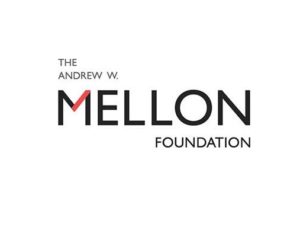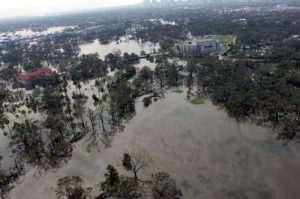 Article originally posted on mellon.org. A guest post by Thomas F. R. Clareson, senior consultant for digital and preservation services at LYRASIS and project director of Performing Arts Readiness.
Article originally posted on mellon.org. A guest post by Thomas F. R. Clareson, senior consultant for digital and preservation services at LYRASIS and project director of Performing Arts Readiness.
Beginning the weekend of August 26–27, Hurricane Harvey bore down on Texas and Western Louisiana, surpassing records for total rainfall from a single hurricane in the continental US, and displacing thousands of families. It’s too soon to tell exactly how much damage the storm has caused, but we know it’s far-reaching and not over. As the country’s fourth-largest city, Houston is home to a number of venerable arts and cultural institutions, including the Museum of Fine Arts Houston, the Contemporary Arts Museum Houston, the Menil Collection, and the Houston Grand Opera’s Wortham Theater Center. While early assessment of these venues suggests low-level or moderate damage, others like the Alley Theatre and the Rockport Center for the Arts did not fare as well, and smaller arts and cultural organizations may not be on responders’ radar yet.
As we plan for natural disasters and the safety of individuals, we often neglect the institutions that capture our history and preserve memories of American life, allowing us to explore and better understand our national culture. When museums, libraries, and performing arts venues are at their most vulnerable, the National Endowment for the Arts (NEA), the National Endowment for the Humanities (NEH) and the Institute of Museum and Library Services (IMLS) are essential responders with a responsibility to preserve and protect these invaluable resources. Where collections have been damaged by hurricanes, earthquakes and other disasters, these federal agencies can—and do—respond quickly. These funders work in collaboration with other key federal and national organizations such as the Federal Emergency Management Agency (FEMA) and the Smithsonian Institution when disasters strike.
Regional preservation professionals supported by NEH funding were among the first on the scene when Tropical Storm Allison flooded Houston with over forty inches of rainfall in June 2001. Their response saved historic photographs, unique film footage, and regional history materials from libraries, archives, and museums. In the days after Hurricane Katrina, NEH, NEA, and IMLS joined other key agencies to conserve artifacts central to New Orleans’ vibrant culture. Years later, when Hurricane Sandy hit New York and New Jersey, these same federal agencies supported efforts to save buildings, collections, and business records from museums, galleries, performing arts organizations, and libraries, helping each rebuild and resume operations—from staging performances to providing access to rare and unique collections.

NEA’s State and Regional Partnerships Program has provided funding for State Arts Agencies to support recovery for organizations and artists affected by disasters. Grants have addressed disasters at varying levels—local arts organizations damaged by the 2011 tornado in Joplin, Missouri; performing arts centers affected by flooding during several years across the state of Iowa; and countless organizations across the Gulf Coast region after Hurricanes Katrina and Rita. In working with national arts service organizations, NEA awarded a grant to New Orleans’ National Performance Network to facilitate monthly roundtable meetings between cultural organizations and artists to address cultural rebuilding efforts throughout the city. A portion of the funding was allocated to aid Louisiana-based touring artists after Hurricane Katrina.
Similarly, for nearly 30 years the NEH has provided support for consulting and educational programs on a wide range of topics to protect cultural heritage collections, repositories, staff, and users. NEH’s Preservation Assistance Grant program is specifically targeted to small and mid-sized archives, historical organizations, libraries, and museums where disaster preparedness is central to long-term collection and preservation. Since 2000, these grants have reached over two thousand organizations. They provide disaster recovery training and opportunities to consult with preservation professionals on the development of disaster preparedness plans, as well as funds for recovery supplies.
NEH also provides support for Regional Preservation Field Service Programs, which enable nonprofit staff to work with arts and cultural institutions large and small to provide help with disaster plan development, webinars and workshops on disaster preparedness, and telephone and email support, giving staff members at disaster-affected cultural heritage institutions access to expert help 24/7.
Between 1990 and 2010, NEH provided over 120 organizations damaged by disasters with Emergency Grants. Funding from these grants was used for a variety of critical needs, including replacing collection materials, adding equipment to battle humidity problems after floods, and protecting collections against future earthquake damage. On August 30, NEH announced the availability of $1 million in emergency grants to institutions damaged by Hurricane Harvey.
The findings of a 2005 report, “A Public Trust at Risk: The Heritage Health Index Report on the State of America’s Collections,” inspired the Connecting to Collections program. Through this initiative, the Institute of Museum and Library Services offered Statewide Preservation Planning and Implementation Grants between 2007-2014, providing funds to focus on improving disaster planning for individual institutions and on a statewide basis. The Connecting to Collections Care Online Community produces webinars and courses on collections care for small-to-mid-sized organizations to this day.
Federal support has been critical too in supporting initiatives assisting art and cultural organizations in preparing for and mitigating damage from man-made and natural disasters. For example, dPlan, an automated disaster-planning tool from the Northeast Document Conservation Center (NEDCC) and the Massachusetts Board of Library Commissioners (MBLC) and funded in part by IMLS, has enabled thousands of organizations to enter data into an online disaster plan template to create a customized disaster plan.
NEA has provided grants as a founding member of the National Coalition for Arts’ Preparedness and Emergency Response, which works to build a national safety net for artists and arts organizations affected by crises. NEA has also supported South Arts’ ArtsReady tool, an online emergency preparedness tool that provides arts organizations with customized business continuity plans for sustainability after emergencies and disasters. In 2016, NEA held a convening on Organizational Readiness and Resiliency that included federal partners such as the Department of the Interior and the Federal Emergency Management Agency (FEMA), resulting in a planning document for future collaborative work across the arts community to prepare for and respond to disasters. Immediately following Hurricane Harvey’s landfall, NEH staff were centrally involved in the initial conference calls to coordinate and support recovery efforts in the arts sector.
Collaboration before, during, and after disasters strike helps organizations establish recovery plans in advance, and manage the aftermath in partnership with national colleagues. FEMA and the Smithsonian Institution coordinate The Heritage Emergency National Task Force, a group of 42 organizations that come together during times of regional and national emergency to share resources and best practices for addressing emergency situations. A key player in the Task Force is The Foundation of the American Institute for Conservation of Historic and Artistic Works (FAIC), which leads the Alliance for Response, a well-known initiative long funded by NEH that has helped to launch more than 25 cooperative disaster recovery networks across the country.
Recognizing that performing arts organizations can be vulnerable to emergencies and disasters of all kinds, resulting in destabilizing or catastrophic loss of income and assets, the Mellon Foundation created the Performing Arts Readiness (PAR) project in 2017. The PAR project brings together leading service organizations, including five performing arts service organizations and five regional preservation and conservation centers, to specifically address building capacity for disaster preparedness and recovery for performing arts organizations. The project is leveraging the needs and expertise of the preservation/conservation and performing arts communities to improve readiness and response practices across a broad spectrum of the cultural infrastructure. The initiative will aid performing arts organizations nationwide as they learn how to protect their assets, sustain operations, and prepare for emergencies.
Performing arts organizations are important community centers, places of business, and cultural anchors. The PAR project offers community engagement and advocacy to emphasize the importance of disaster preparedness; online and in-person education; model policy and best practice development; preparedness planning tools (including enhancements to the ArtsReady and dPlan tools); an emergency preparedness mentoring program for cities and states; and grants to build or enhance emergency networks and institutional emergency plans.
The organizations involved in PAR and the constituents who utilize their services strongly support the work of NEA, NEH, and IMLS, especially in the trying times of disasters. Throughout my 30-year career in preservation, I’ve seen how important it is that these federal funders aid cultural heritage and performing arts organizations as they prepare for and recover from disasters. As the prevalence of natural and man-made disasters increases across the US, maintaining the work of the NEA, NEH, and IMLS is crucial to providing a safety net for the arts and culture community nationwide.
It is the responsibility of each of us to ensure that these funders and other government agencies can assist individual organizations and states that are in harm’s way. By raising the needs of the arts and cultural sector in preparedness and recovery policy, and diversifying funding for emergency work from local, state, national, federal, and foundation resources, we can guarantee that our national heritage and culture will be protected for future generations.
